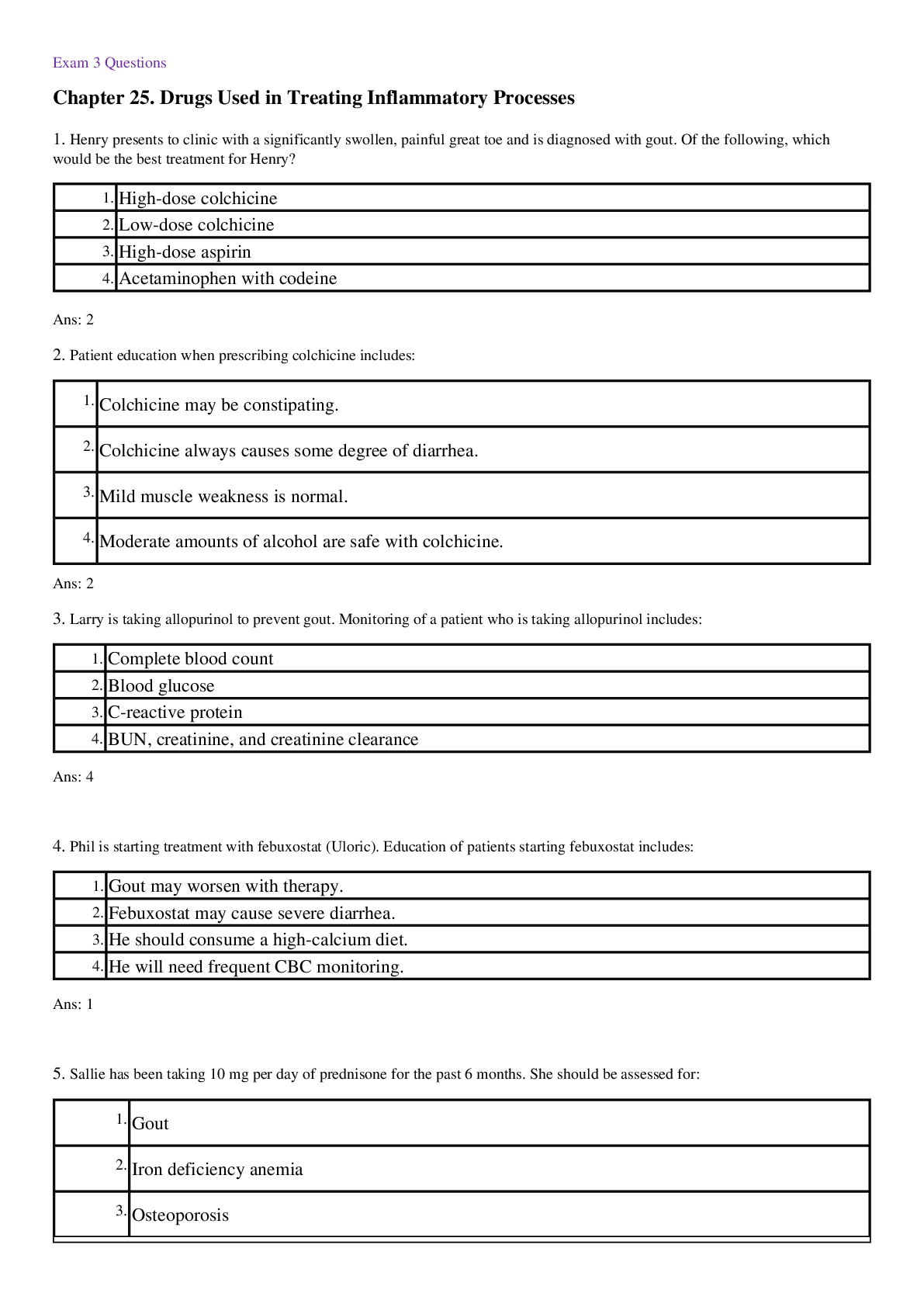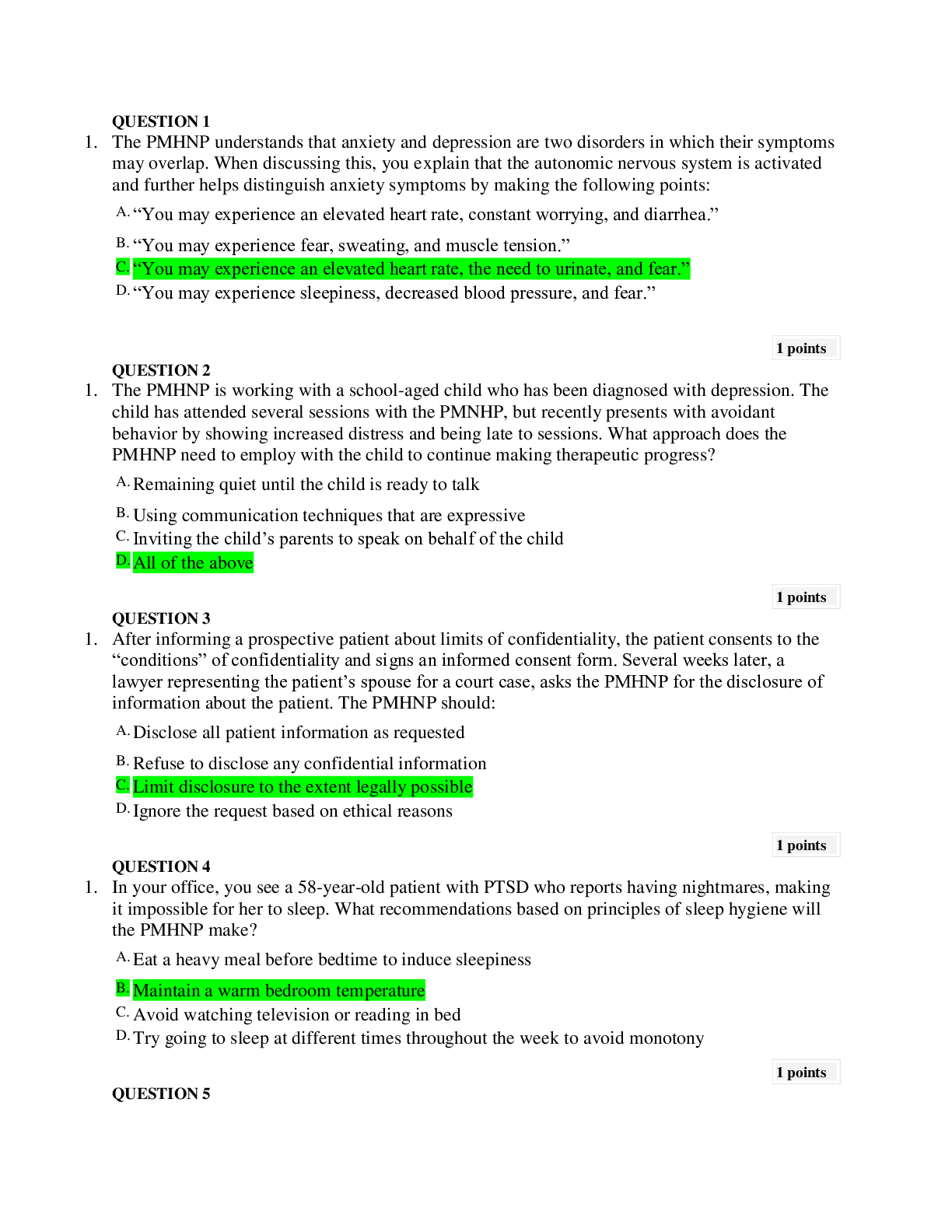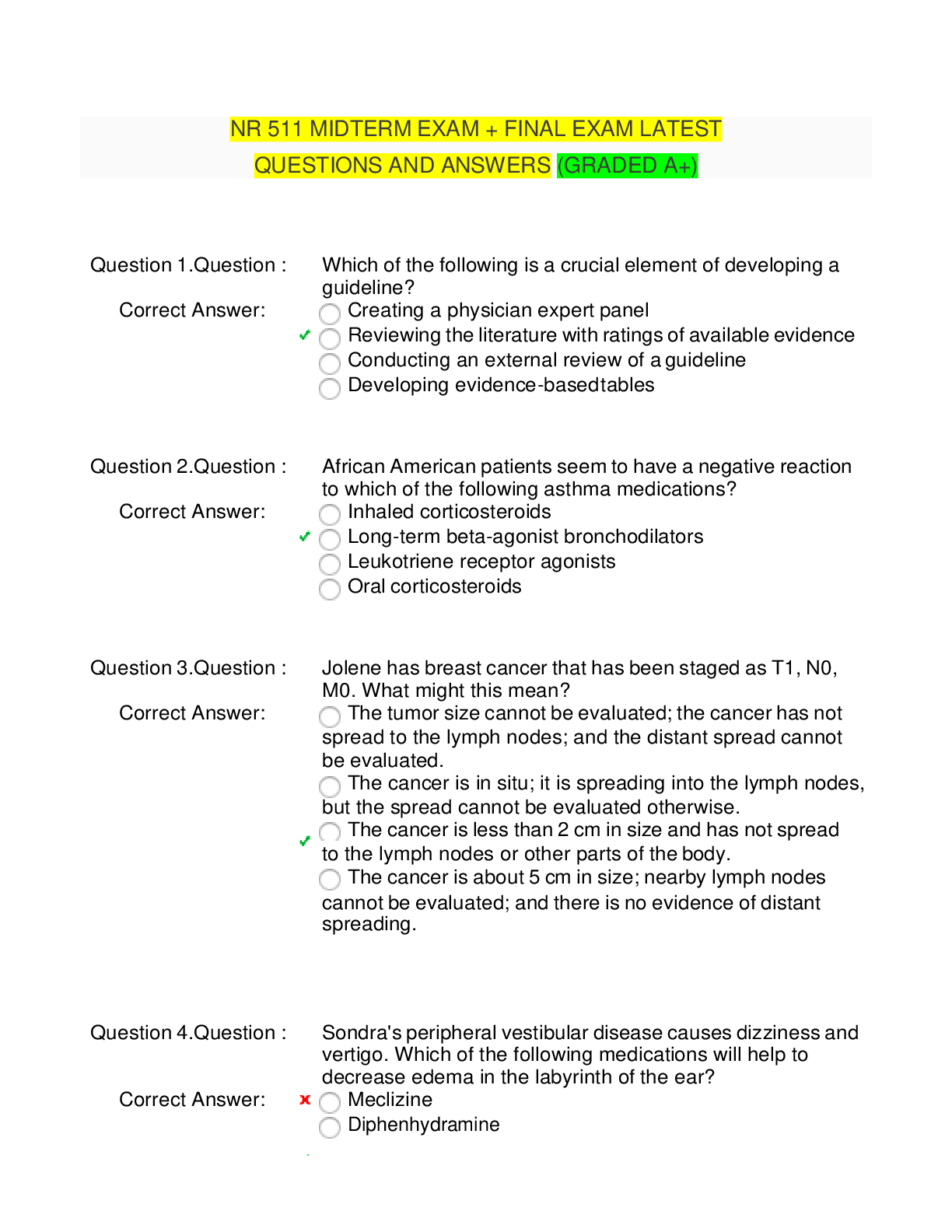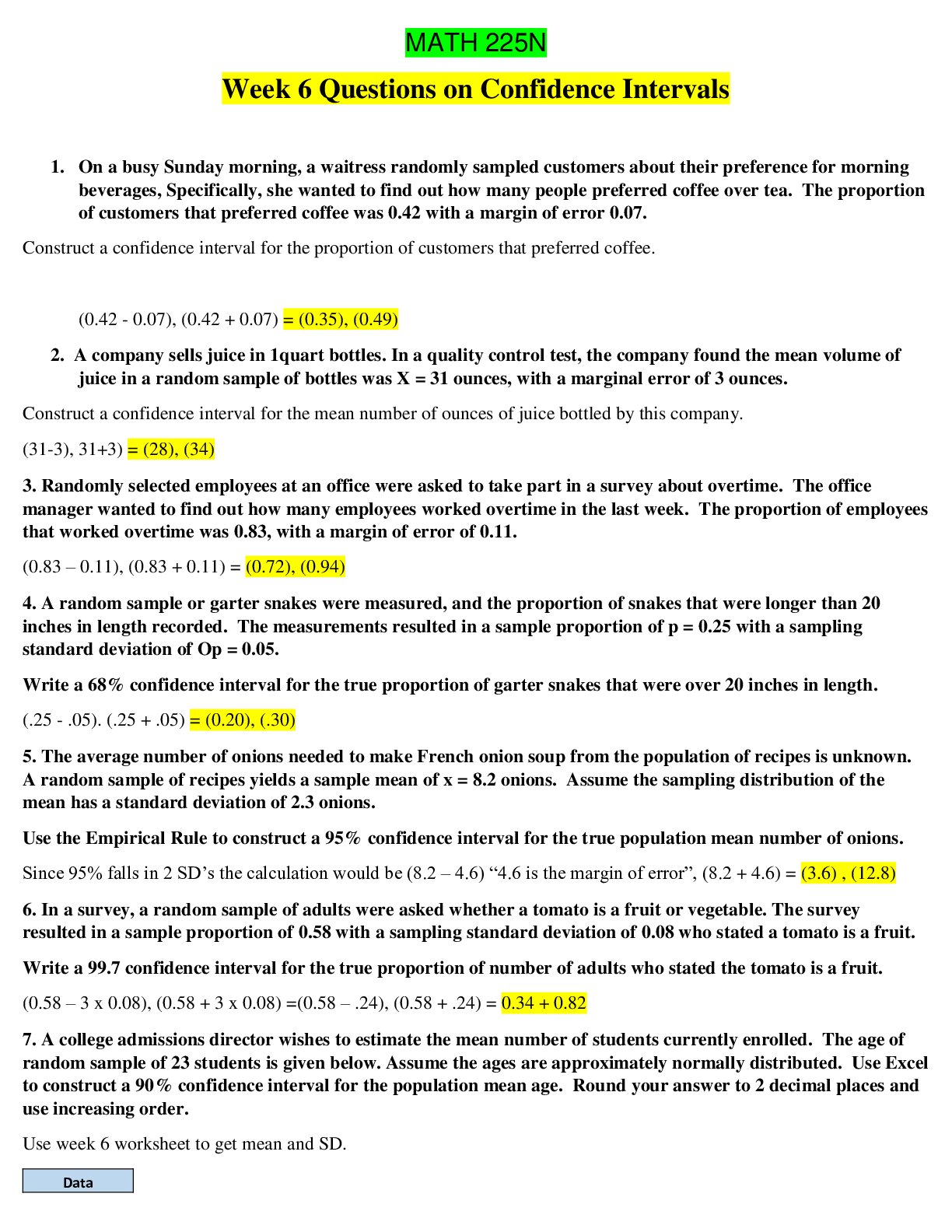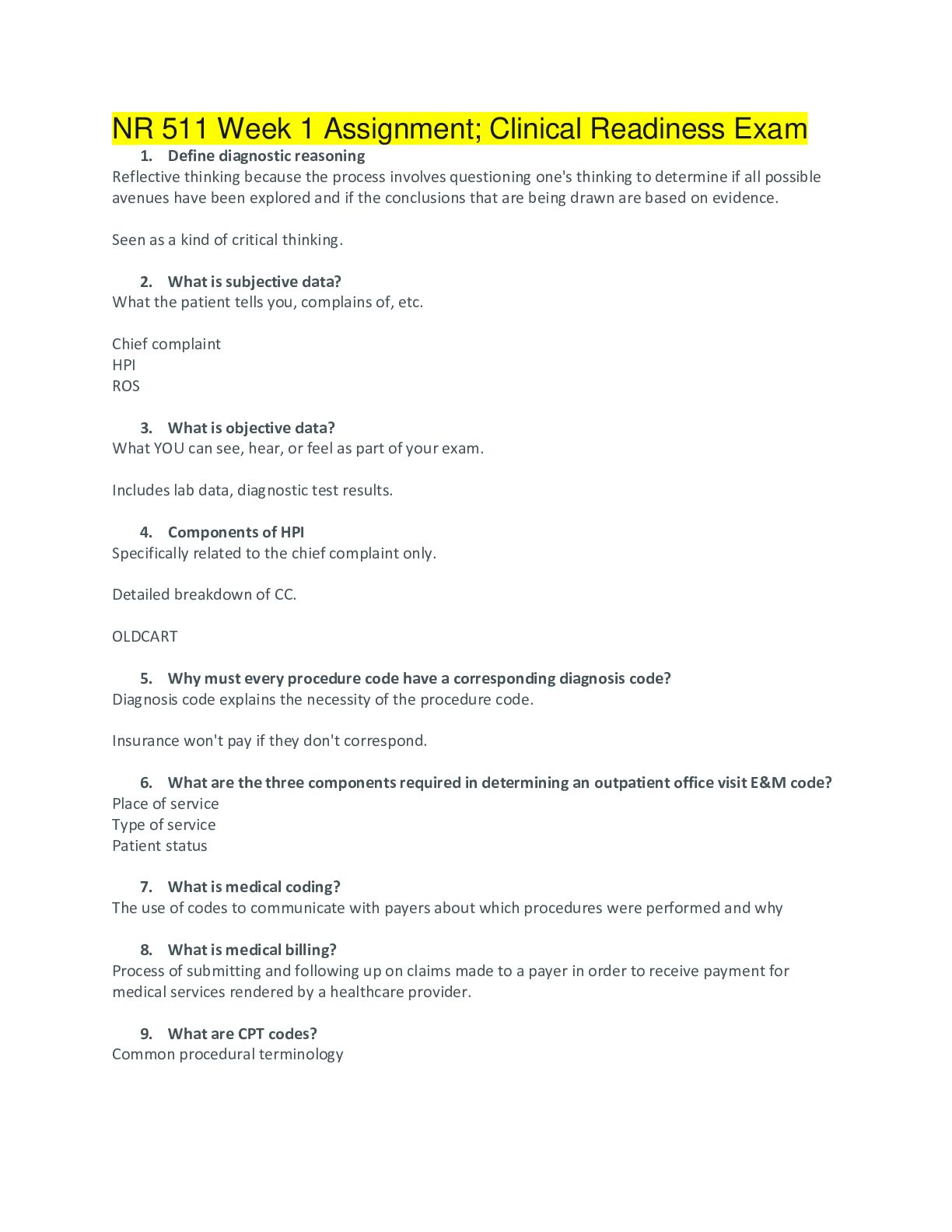Psychology > EXAM > PSYC101 Final Exam 1, Exam 2, Exam 3 and Exam 4 Questions and Answers All Graded A (All)
PSYC101 Final Exam 1, Exam 2, Exam 3 and Exam 4 Questions and Answers All Graded A
Document Content and Description Below
Version A PSYC101 Final Exam (Fall 2015) 1 PSYC101 Final Exam 1, Exam 2, Exam 3 and Exam 4 Name (required): __________________________ Student ID: _______________________________ To do li... st: Write your exam version on your Scantron above your name. Bubble-in your name on the Scantron. Mark your answers using the Scantron provided. Once you have completed the exam, bring your exam and Scantron to the front of the class. The final exam is worth a total of 100 points and is made up of 90 multiple-choice questions. Exam 1 1. A leading humanistic thinker who introduced a major theory of motivation with a goal of self-actualization was ____. a. Abraham Maslow b. Alan Newell c. Herbert Simon d. Carl Rogers 2. In an experimental study on the effects of sleep deprivation on depression, the number of hours that a participant stays awake is represented by the ____. a. Random variable b. Independent variable c. Dependent variable d. Control variable 3. Hermann von Helmholtz’s work on ____ provided further evidence that the mind had a physical basis. a. Dissection and human anatomy b. The range of human hearing c. The mind-body dichotomy d. The speed of nerve conduction 4. Statistical methods that allow experimenters to extend conclusions from samples to larger populations are called ____. a. Descriptive statistics b. Probability distributions c. Representative samplesVersion A PSYC101 Final Exam (Fall 2015) 2 d. Inferential statistics 5. Alejandro is developing a preliminary research study to address the question of whether 4-year-olds who are asked to delay gratification (e.g., to delay eating candy) perform differently in solitude than with other 4- year-olds. Which combination of research perspectives would be best for this preliminary study? a. Biological and the individual differences approach b. Developmental psychology and social psychology c. Cognitive psychology and evolutionary psychology d. Evolutionary psychology and clinical psychology 6. The philosophies of monism and dualism address which of the following questions? a. Does the mind operate through innate processes or is it formed through experience? b. How does one study the processes of the mind? c. Does the mind work as the sum of its parts or as individual elements? d. What is the relationship between the body and mind? 7. During the lecture on learning and memory tips (or How to get an “A” in this class), I described ____________ which is the idea that introducing certain difficulties into the learning process can greatly improve long-term retention of the learned material. a. the font size study b. the normal curve c. desirable difficulties d. mental chronometry 8. If we restrict our thinking about an aspect of mind to the information provided by one psychological perspective, at worst, the result may ____. a. be incomplete b. lead us in the wrong direction c. be overly simplistic d. lack depth 9. The mean, median, and mode are all measures of a data set’s ____. a. Frequency distribution b. Numerical average c. Variability d. Central tendency 10. If the results from two groups are statistically different and the manipulation (the independent variable) caused the difference we would say the result is _________________. a. Randomized b. Statistically significant c. Null hypothesis d. Due to chance 11. Entering the 21st century and armed with in-depth research results compiled in the various perspectives, psychologists are returning to ____. a. the structuralist view of the mind b. viewing the mind as a set of building blocks based on introspection c. viewing the “the whole as greater than the sum of its parts” d. a more eclectic, or comprehensive, view of the mind 12. Which correlational coefficient represents the strongest relationship? a. -.95 b. -.75 c. 1.25 d. .75Version A PSYC101 Final Exam (Fall 2015) 3 13. Psychology as a hub science tells us that ____. a. psychological research is well-funded b. the general population is intrigued by the study of human behavior c. psychology is one of the oldest disciplines d. many disciplines require an in-depth understanding of people 5. The first official psychological experiment involved ____. a. observing the behavior of cats when escaping puzzle boxes b. measuring how quickly, after hearing a ball drop onto a platform, a person could respond by striking a telegraph key c. the salivation of dogs in anticipation of food in response to the arrival of the handler d. the use of a stroboscope to control the timing of the appearance of two black lines against a white background 6. Wilhelm Wundt’s student, Edward Titchener, developed an approach in which the mind is broken into the smallest elements of mental experience. What was this called? a. structuralism b. functionalism c. behaviorism d. humanism 7. Functionalism emerged partly in response to the publication of ____. a. Great Expectations, by Charles Dickens b. The Prince and the Pauper, by Mark Twain c. The Origin of the Species, by Charles Darwin d. Far from the Madding Crowd, by Thomas Hardy 8. Which of the following proverbs best describes Gestalt theory? a. A chain is only as strong as its weakest link. b. The more things change, the more they stay the same. c. A little knowledge is a dangerous thing. d. The whole is greater than the sum of its parts. 10. Which of the following research questions is most likely to be asked by a cognitive psychologist? a. To what extent is student learning influenced by the socio-cultural makeup of the class? b. Do students learn material better when the learning takes place over time or when they “cram” for an exam? c. Are there common characteristics among students who graduate in the top one percent of their class? 13. The psychological perspective that seeks to explain, define, and treat abnormal behaviors is called ____. a. the individual differences perspective b. clinical psychology c. developmental psychology d. evolutionary psychology 16. A set of facts and relationships between facts that can explain and predict related phenomena is called a(n) ____. a. theory b. hypothesis c. descriptive method d. experiment 17. A proposed explanation for a situation, usually taking the form “if A happens then B will be the result” is called a(n) ____.Version A PSYC101 Final Exam (Fall 2015) 4 a. theory b. research proposal c. experiment d. hypothesis 18. A subset of a population being studied is called a ____. a. sample c. demographic b. cohort d. cluster 21. Consider the following relationships between two variables. Which pair is most likely to have the weakest correlation? a. hair color and intelligence c. salary and educational level b. height and weight d. age and verbal ability up to age 20 24. An inactive substance or treatment that cannot be distinguished from a real, active substance or treatment is called a ____. a. false positive b. placebo c. remedy d. sample 33. During the lecture on learning and memory tips (or How to get an “A” in this class), I warned the class about several techniques students report using to prepare for exams. ____________ is one such technique that could lead to an illusion of learning. a. re-reading the chapter multiple times b. excessive highlighting in the text c. copying one’s notes d. all of the above 35. True/False: “Cramming” (or massing your study) leads to higher performance when the test is very soon but “spacing” (or distributing your study over time) leads to higher performance when the test is more than a day later. a. True b. FalseVersion A PSYC101 Final Exam (Fall 2015) 5 Exam 2 1. Christopher suffered a traumatic brain injury in an automobile accident. Since the accident, he has great difficulty in forming new memories but remembers his childhood well, which suggests that his ____ was damaged. a. Hippocampus b. Hypothalamus c. Basal ganglia d. Amygdala 2.Maria is the victim of an armed robbery. She is called into the police station to identify her assailant from a line-up of men. She correctly reports that none of the men were her attacker. This illustrates the concept of a(n) ____. a. Hit b. Elimination c. Correct rejection d. Accurate refusal 3. Once the “threshold” for an action potential is reached what is the sequence of events that occur? 1. Potassium channels are activated and potassium ions move out of the neuron. 2. Sodium channels are activated and sodium ions move into the neuron. 3. The interior of the neuron becomes more negatively charged than the exterior. 4. The interior of the neuron becomes more positively charged than the exterior. a. 1, 3, 4, 2 b. 2, 4, 1, 3 c. 4, 1, 2, 3 d. 3, 2, 1, 4 4. Mosquito ringtones in class were used to demonstrate absolute threshold. I first presented a low frequency stimulus that everyone could hear and continued in an ascending fashion to a high frequency stimulus that no one could hear. Because I was controlling the stimulus for you (the participant), I was using the method of ___________ . a. Constant Stimuli b. Adjustment c. Limits d. Difference 5. How do drugs classified as “SSRIs,” such as Prozac, alter neuronal communication? a. They increase the effectiveness of the neurotransmitter serotonin by stopping its diffusion from the synaptic cleft. b. They decrease the effectiveness of the neurotransmitter serotonin by returning it to the axon terminal for recycling. c. They increase the effectiveness of the neurotransmitter serotonin by blocking its reuptake into the axon terminal. d. They decrease the effectiveness of the neurotransmitter serotonin by facilitating its metabolism by neuronal enzymes. 6. Sleep researchers can categorize brain waves according to their frequency and amplitude. If a person was in the deepest stages of sleep (Stage 3 or 4), his or her brain waves would show _______ frequency and ______ amplitude. a. Low, low b. Low, high c. High, high d. High, low 7. The arrival of a(n)____ causes synaptic vesicles to be released from their protein anchors, allowing the vesicles to fuse with the cell membrane and release ____ into the synaptic cleft.Version A PSYC101 Final Exam (Fall 2015) 6 a. Action potential; neurotransmitters b. Neurotransmitter; electrical charge c. Action potential; electrical charge d. Neurotransmitter; more neurotransmitter 8. Which structure of the ear contains the auditory receptors? a. Cochlea b. Tympanic membrane c. Pinna d. Auditory nerve 9. Before entering the auditory canal, sound waves are funneled into the outer ear via the ____. a. Cochlea b. Eustachian tube c. Oval window d. Pinna 10. In the middle ear, the purpose of three tiny bones known as the ossicles is to ____. a. buffer sound waves before entering the inner ear b. decode the frequency and amplitude of sounds waves c. transfer sound energy to the fluid of the inner ear d. directly stimulate the auditory nerve 11. The _______________________ theory of dreams argues that there is no inherent meaning in dreams and that the brain is simply attempting to make sense of the brain’s activity during sleep. a. Psychoanalytic b. Activation Synthesis c. Evolutionary d. Cannon-Bard 1. Maxwell is a participant in a research study aimed at understanding how the brain responds to prolonged periods of isolation. After spending several hours in a room alone, Maxwell undergoes a(n) ____ procedure; a method that measures the brain’s electrical activity using electrodes placed on the scalp. a. skin conductance response c. magnetoencephalography b. electroencephalogram d. electrical stimulation 4. What distinguishes a neuron from most other cell types? a. It can translate proteins. b. It contains DNA. c. Its nucleus is contained within the cell body. d. It has specialized features for sending and receiving messages. 6. How do dendrites facilitate neuronal communication? a. They provide structural support for the neuron. b. They select the type of neurotransmitter that is released. c. They allow a neuron to receive multiple inputs from other neurons. d. They increase the speed of action potentials. 8. Melanie, a graduate student working in a neuroscience lab, grows neurons in a petri dish to study the effects of environmental toxins on neuronal communication. During one of Melanie’s experiments, she accidentally damages the axon of a neuron. What will be an immediate consequence of this mishap? a. The neuron will not be able to transmit information to other cells. b. The neuron will not be able to translate proteins. c. The neuron will not be able to receive inputs from other cells. d. The neuron’s other axons will have to take over the function of the damaged axon.Version A PSYC101 Final Exam (Fall 2015) 7 11. The brain and the spinal cord form the ____. a. autonomic nervous system c. peripheral nervous system b. central nervous system d. somatic nervous system 14. The ____ is the lobe of the cerebral cortex located at the back of the brain in which the ____ is located. a. frontal lobe; primary auditory cortex b. parietal lobe; Wernicke’s area c. temporal lobe; primary somatosensory cortex d. occipital lobe; primary visual cortex 21. What is one way rods differ from cones in the retina? a. Rods are less sensitive to light than cones. b. In contrast to cones, rods are optimally activated by light entering the center of the eye. c. Unlike cones, rods cannot detect color. d. Rods provide the ability to see sharper images than cones. 23. One theory of color vision is based on the existence of different types of receptors for the detection of short, medium, and long wavelengths. What is this theory? a. The tricolor detection scheme c. The trichromacy theory b. The primary paradigm d. The tiered wavelength model 31. What does it mean to be conscious? a. Consciousness means having different levels of alertness b. Consciousness means being aware of ongoing sensations c. Consciousness means being aware of oneself (e.g., self-awareness, the rouge test) d. all of the above, consciousness has multiple meanings 36. Sigmund Freud suggested that dreams reveal the presence of deep secrets that the unconscious part of the mind was trying to hide from its conscious awareness. a. True b. False 40. True/False: As people get older, they spend less and less time in REM sleep. In contrast, newborns spend approximately 50% of the time in REM sleep. a. True b. FalseVersion A PSYC101 Final Exam (Fall 2015) 8 Exam 3 1. Semantic or episodic memories that reference the self are called ____. a. autobiographical memories b. procedural memories c. self-reflective memories d. nondeclarative memories 2. Which model or theory of emotion proposes that general arousal leads to assessment, which in turn leads to subjective feelings? a. James-Lange theory b. 0Schachter-Singer two-factor theory c. Somatovisceral Afference Model of Emotion d. Cannon-Bard theory 3. The development of a learned response is called ____. a. generalization b. higher order conditioning c. habituation d. acquisition 4. During class we watched a video of bees that were trained to sniff out explosive materials. The training involved classical conditioning techniques in which bees learned to associate the odor of explosive material with a sugar solution (food) which elicited a proboscis extension reflex (PER). In this example, the neutral stimulus which became the conditioned stimulus was the __________ and the conditioned response was the __________. a. PER, explosive material b. Sugar solution, PER c. Explosive material, PER d. PER, sugar solution 5. Which scenario supports the James-Lange theory of emotion? a. Tony approaches his friend Juanita, who is walking her dog. As the dog begins to bark, Tony’s heart races; he thinks about why this is the case, and realizes he has a crush on Juanita. b. Micah wakes up feeling glum. He forces himself to smile from ear-to-ear and laugh out loud, and then he begins to feel happy. c. Bethany feels very depressed about her recent break-up with her boyfriend. She slumps down on her couch and cries for an hour straight, and then she begins to feel better. d. Aaron relaxes in his hammock. Suddenly, he feels an earthquake, causing him to feel afraid; at the same time, his heart beats rapidly and his palms sweat. 6. Tom often smokes while studying in his apartment. Of course, he cannot smoke during his exams. This may make retrieval of the material more difficult because of ____. a. encoding specificity b. episodic memory c. storage and retrieval d. short-term memory 7. According to the levels of processing theory, the depth (shallow to deep) of processing ____. a. enhances long-term memory capacity b. predicts the duration of information in long-term memory c. predicts the ease of retrieval d. exemplifies the power of maintenance rehearsal 8. Which nervous system structure participates in the general arousal associated with emotional states? a. cranial nervous system b. somatic nervous systemVersion A PSYC101 Final Exam (Fall 2015) 9 c. autonomic nervous system d. encephalic nervous system 9. After a stressful day of work, Randi often makes small burn marks on her inner arm with a cigarette; which she feels helps her sleep better at night. This type of behavior is an example of ____. a. positive punishment b. negative reinforcement c. positive reinforcement d. negative punishment 10. Results from the __________ procedure, would suggest that the capacity of sensory memory is just over 4 items. However, using the __________ procedure, Sperling & Averbach were able to determine that the capacity of sensory memory is much, much larger. a. Brown-Peterson, digit-span b. digit-span, Brown-Peterson c. whole-report, partial-report d. partial-report, whole report 1. What do motivation and emotion have in common? a. They both arouse an organism to stimulate some type of behavior. b. They both stimulate behavioral changes in a specific manner. c. They both cause a prolonged change in behavior. d. They both lead to general rather than specific behavioral changes. 4. Sally loves to run, and works jogging into her daily schedule because of the “runner’s high” she experiences. Sally is motivated by a(n) ____ reward. a. top-down c. extrinsic b. bottom-up d. intrinsic 11. Which scenario supports the Cannon-Bard theory of emotion? a. Tony approaches his friend Juanita, who is walking her dog. As the dog begins to bark, Tony’s heart races; he thinks about why this is the case, and realizes he has a crush on Juanita. b. Micah wakes up feeling glum. He forces himself to smile from ear-to-ear and laugh out loud, and then he begins to feel happy. c. Bethany feels very depressed about her recent break-up with her boyfriend. She slumps down on her couch and cries for an hour straight, and then she begins to feel better. d. Aaron relaxes in his hammock. Suddenly, he feels an earthquake, causing him to feel afraid; at the same time, his heart beats rapidly and his palms sweat. 13. True/False: According to one study (Christakis & Fowler, 2007) that analyzed social circles, a person who has obese friends is more likely to be obese than a person who has an obese spouse. a. True b. False 14. Paul Ekman and colleagues examined the universality of emotions, from a series of studies investigating emotional expression and perception cross-culturally they were able to make the claim that there are at least six universal emotions. What emotion below is not part of the six basic emotions: a. Sad b. Surprised c. Fearful d. Guilty 15. In the Capilano Suspension Bridge, participants who walked over the bridge that was higher off the ground misattributed their arousal and ___________________________ more often than the participants who walked across the stable “non-scary” bridge. Version A PSYC101 Final Exam (Fall 2015) 10 a. threw up after they got to stable ground b. had a panic attack while they walked across the bridge c. called the attractive experimenter after the study d. claimed the study was unethical 16. Learning is traditionally divided into three categories: associative, nonassociative, and ____. a. classical c. conditioned b. operant d. observational 17. The process of associating a behavior with its consequences is known as ____. a. habituative learning b. nonassociative learning c. classical conditioning d. operant conditioning 34. Will is ten years old and preparing for a spelling contest. He is starting to memorize the spelling of the word antidisestablishmentarianism. He realizes that he can group the letters into anti, dis, establish, and so forth. This process is called ____. a. rehearsal c. consolidation b. chunking d. encoding 38. In the studies by Warrington and Weiskrantz, amnesic and healthy control participants viewed progressively less degraded images and words and indicated when they knew the image (e.g., airplane) or word (porch). The results of this study indicated that even people who are unable to form new long term declarative memories can still exhibit other forms of long term memory. a. True b. FalseVersion A PSYC101 Final Exam (Fall 2015) 11 Exam 4 4. What was a later critique (or criticism) of the events of the Stanford Prison Study? a. Participants were simply responding to the investigators’ instructions. b. Participants were psychologically unstable. c. Participants’ roles in the study overwhelmed their individuality. d. Participants were too immature for the study. 6. According to Piaget’s theory, cognitive abilities develop through regular stages. This idea is a classic example of ____. a. the continuity approach c. the ecological approach b. the conservation approach d. the discontinuity approach 8. Which of the following Big Five traits had the greatest positive correlation with success across a wide range of professional, skilled, and unskilled job descriptions? a. Agreeableness b. Conscientiousness c. Extraversion d. Openness 9. According to your text, what does the science of personality explore? a. Global patterns of identification, socialization, and adaptation b. Distinctive patterns of morals, desires, and behaviors c. Unique patterns of being, perceiving, and sensing d. Characteristic patterns of thinking, feeling, and behaving 13. Raising awareness of a negative stereotype about a group to which we belong has the ability to reduce our performance, a phenomenon known as ____. This finding has been demonstrated by asking African American and European American students to answer questions from the SAT under different conditions. a. stereotype vulnerability b. discrimination c. stereotype threat d. prejudicial performance 20. In which of the following two scenarios does Grace demonstrate that she has developed theory of mind? (1) Grace accidentally pops Max’s red balloon. Max is furious and heartbroken. Grace tells her mother “Max thinks I did it on purpose.” (2) Grace and Max play contentedly side by side with their blocks. Max builds a tower and Grace builds two small houses. a. Scenario (1) only c. Scenarios (1) and (2) b. Scenario (2) only d. Neither scenario 25. What is a trait? a. A variable in shaping personality based on learning b. A dimension of temperament c. A stable personality characteristic d. A “personality” gene 30. One of the most frequently used personality inventories is the Minnesota Multiphasic Personality Inventory, which was originally designed ____. a. for college and career counseling recommendations b. for marriage and family counseling c. to screen potential public safety employees d. to assist with clinical diagnosisVersion A PSYC101 Final Exam (Fall 2015) 12 32. A judgment about the cause of a person’s behavior is called a(n) ____. a. correspondence b. attribution c. attitude d. bias 34. In a study (Eberhardt, Davies, Purdie-Vaughns, & Johnson, 2006), participants rated stereotypical “Black features” in photographs and predicted the men’s likelihood of being sentenced for murder based on these features. What sentence was most prevalent as the ratings of stereotypical “Black” features increased? a. Life in prison when the victim was White b. Life in prison when the victim was Black c. The death penalty when the victim was White d. The death penalty when the victim was Black 35. Selena, a research scientist, is developing a study of prejudice. Which of the following would be most useful as an implicit measure of prejudice? a. Association of positive terms with Black faces and negative terms with White faces b. Association of geographic locations with demographic groups c. Patterns of higher education for Whites versus Blacks by age group d. Patterns of hiring patterns for White job candidates versus Black job candidates 1. Jean Piaget developed a theory of cognitive development from birth to adulthood. In his theory, children pass through discrete stages. While his theory of development is regarded positively today, researchers have identified several criticisms. For example: a. his theory underestimates the age at which children understand object permanence. b. his theory cannot account for the fact that children have innate naïve theories. c. his theory downplays the effects of social interaction and culture on cognitive development. d. all of the above 10. In Freud’s theory of personality, what is the part of mental activity that cannot be voluntarily retrieved? a. preconscious mind b. unconscious mind c. conscious mind d. superconscious mind 17. What is Piaget’s name for the stage of development that begins at the age of two years and ends at the age of six years and is characterized by use of symbols, egocentrism, and limits on the ability to reason logically? a. formal operational stage c. sensorimotor stage b. concrete operational stage d. preoperational stage 26. Freud revolutionized many aspects of parenting and child care by ____. a. viewing children as miniature adults b. writing a series of books on baby and child care c. recognizing that infants have an active superego much like adults d. viewing children as having different needs at different ages and that childhood experiences matter (i.e., childhood experiences have a long-lasting influence on the person) 28. Each of the Big Five traits consists of a _____. a. continuum, meaning that a person can be high on a particular trait, or low on a particular trait b. core belief c. two-factor correlation d. series of stagesVersion A PSYC101 Final Exam (Fall 2015) 13 29. In Freud’s personality theory, ______________ are protective behaviors that reduce anxiety arising from conflicts between the id, ego, superego. a. Attachments b. Defense mechanisms c. Psychodynamics d. traits 31. The assumption that good things happen to good people and bad things happen to bad people is called a(n) ____. a. just-world belief b. situational attribution c. self-serving bias 33. The correspondence bias causes some people to view a person’s behavior as the result of the person’s disposition, even when the behavior can be completely explained by strong situational factors? a. True b. False 38. An over-simplified set of traits associated with membership in a group or category is called ____. a. prejudice b. discrimination c. a bias d. a stereotype 41. True/False: Developmental psychologists often use an infant’s looking time as a dependent variable. For example it has been determined through looking time analyses that infants prefer whole faces over parts of faces that are jumbled up. a. True b. False 42. To remember the Big Five traits, use the acronym ____. a. STORM b. FRAME c. EARTH d. OCEA [Show More]
Last updated: 1 year ago
Preview 1 out of 13 pages
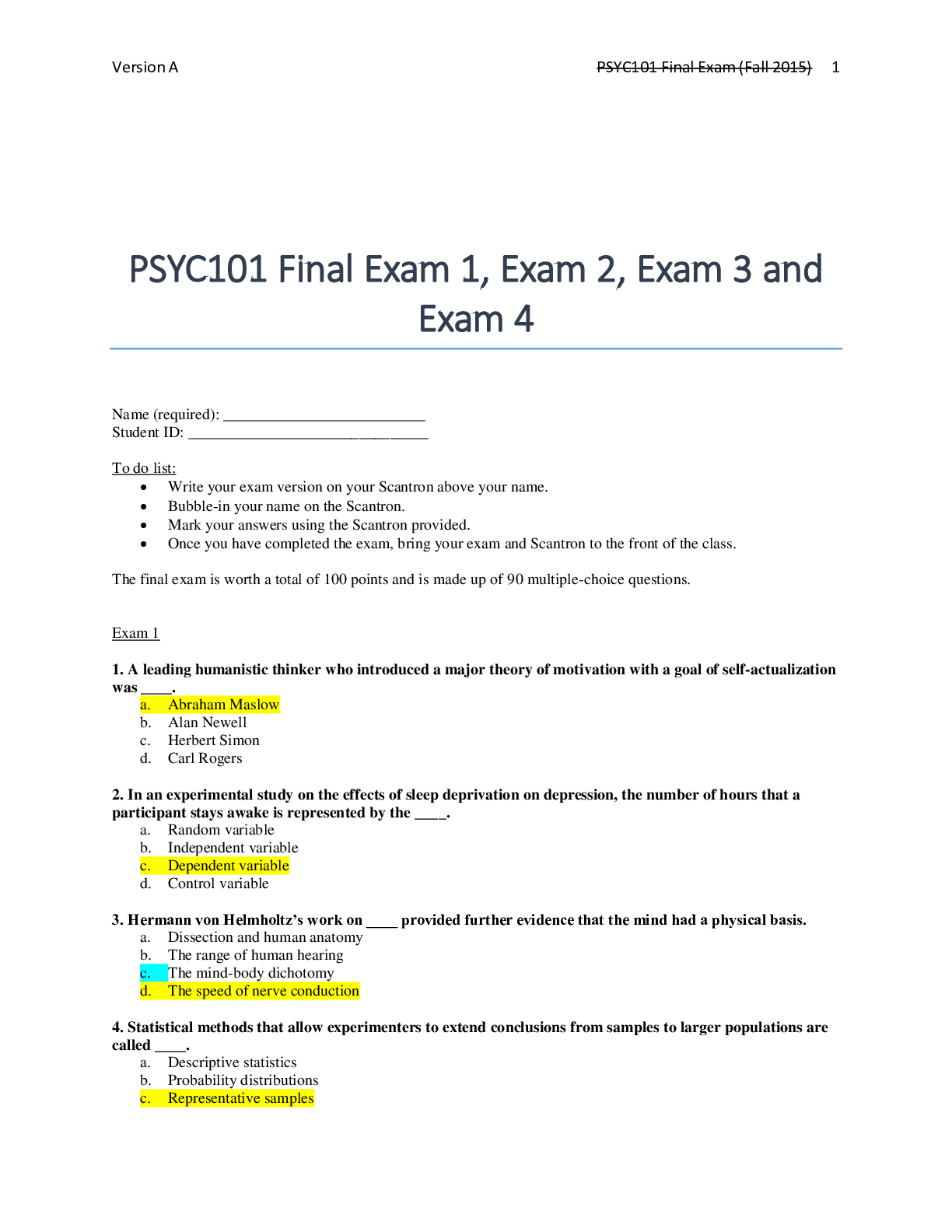
Buy this document to get the full access instantly
Instant Download Access after purchase
Add to cartInstant download
We Accept:

Reviews( 0 )
$11.00
Document information
Connected school, study & course
About the document
Uploaded On
Jun 16, 2021
Number of pages
13
Written in
Additional information
This document has been written for:
Uploaded
Jun 16, 2021
Downloads
0
Views
61

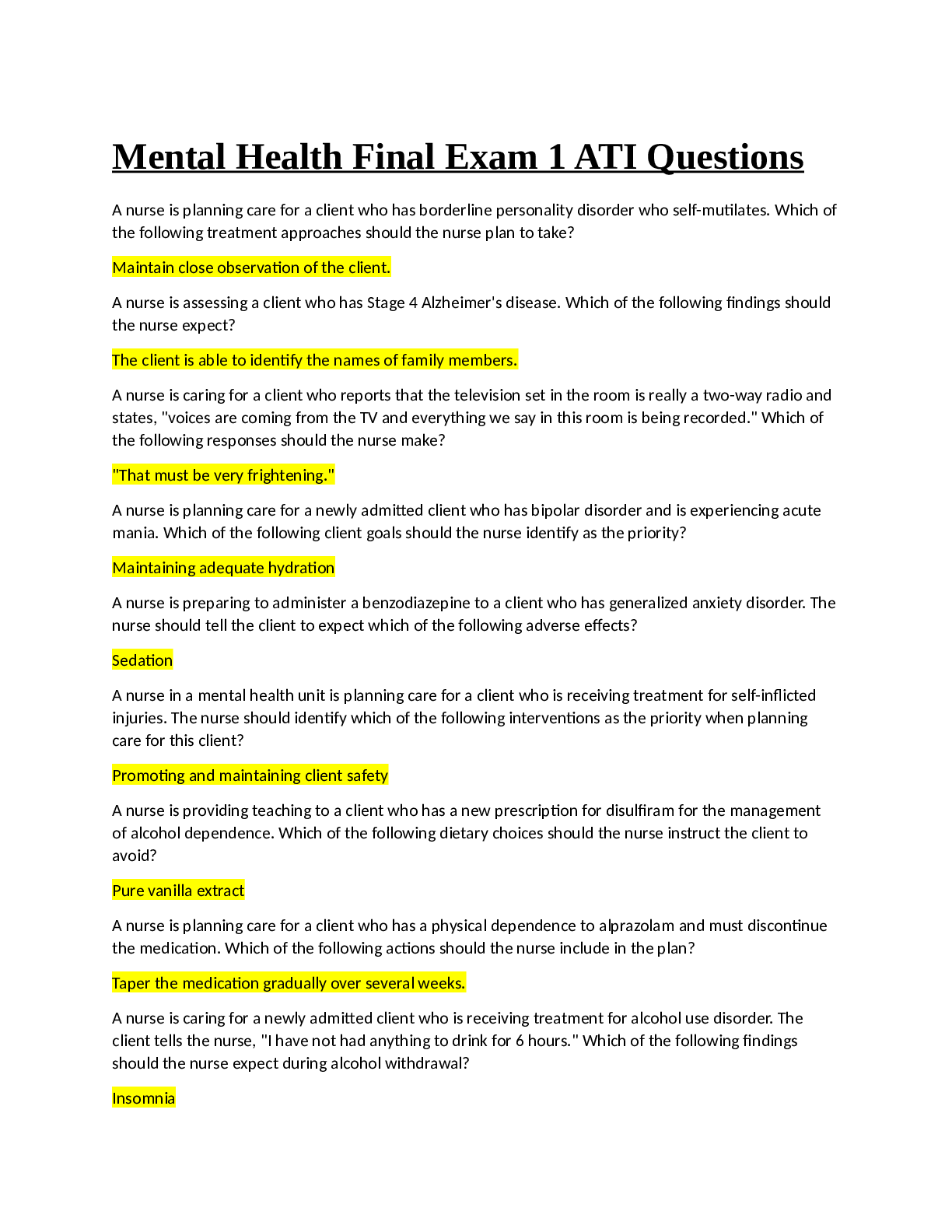
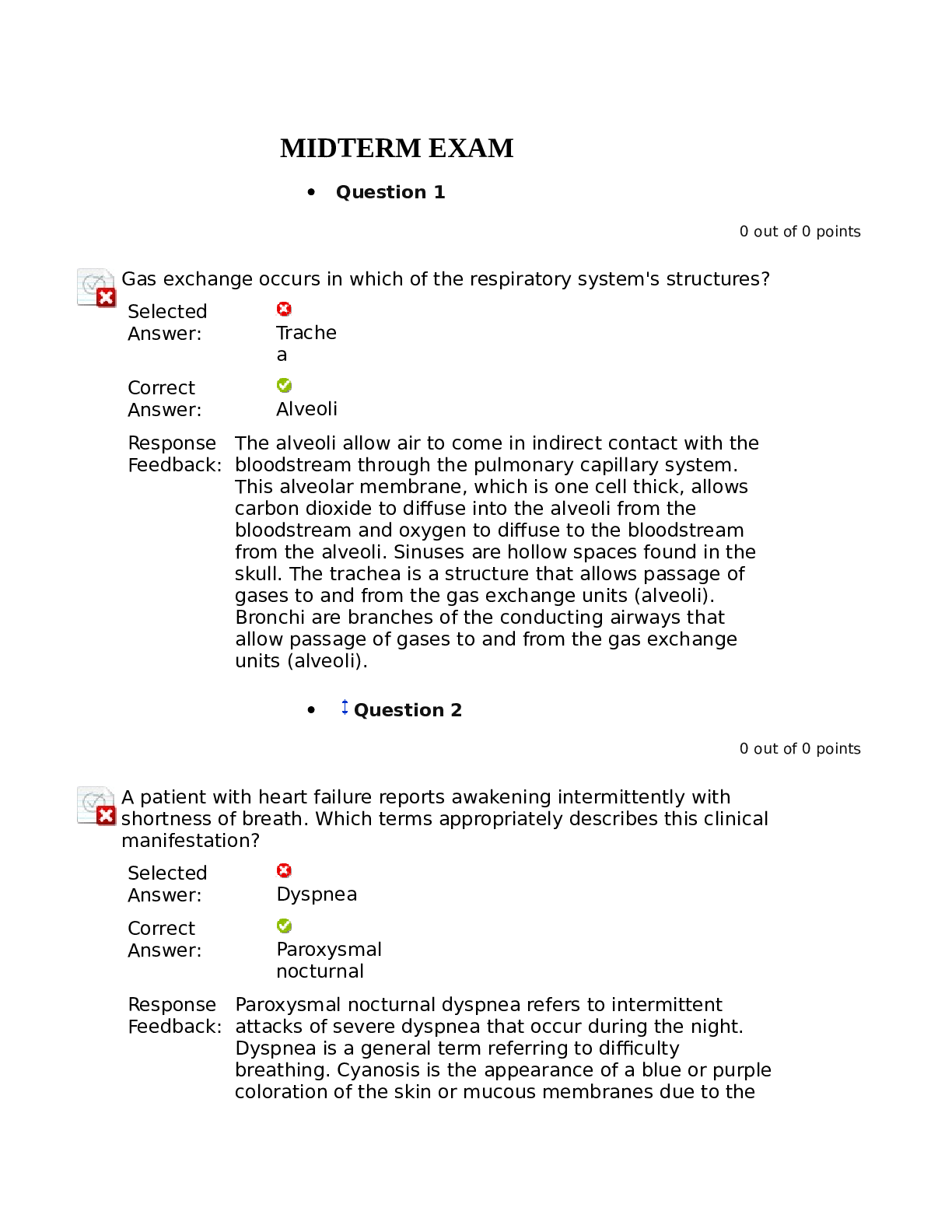
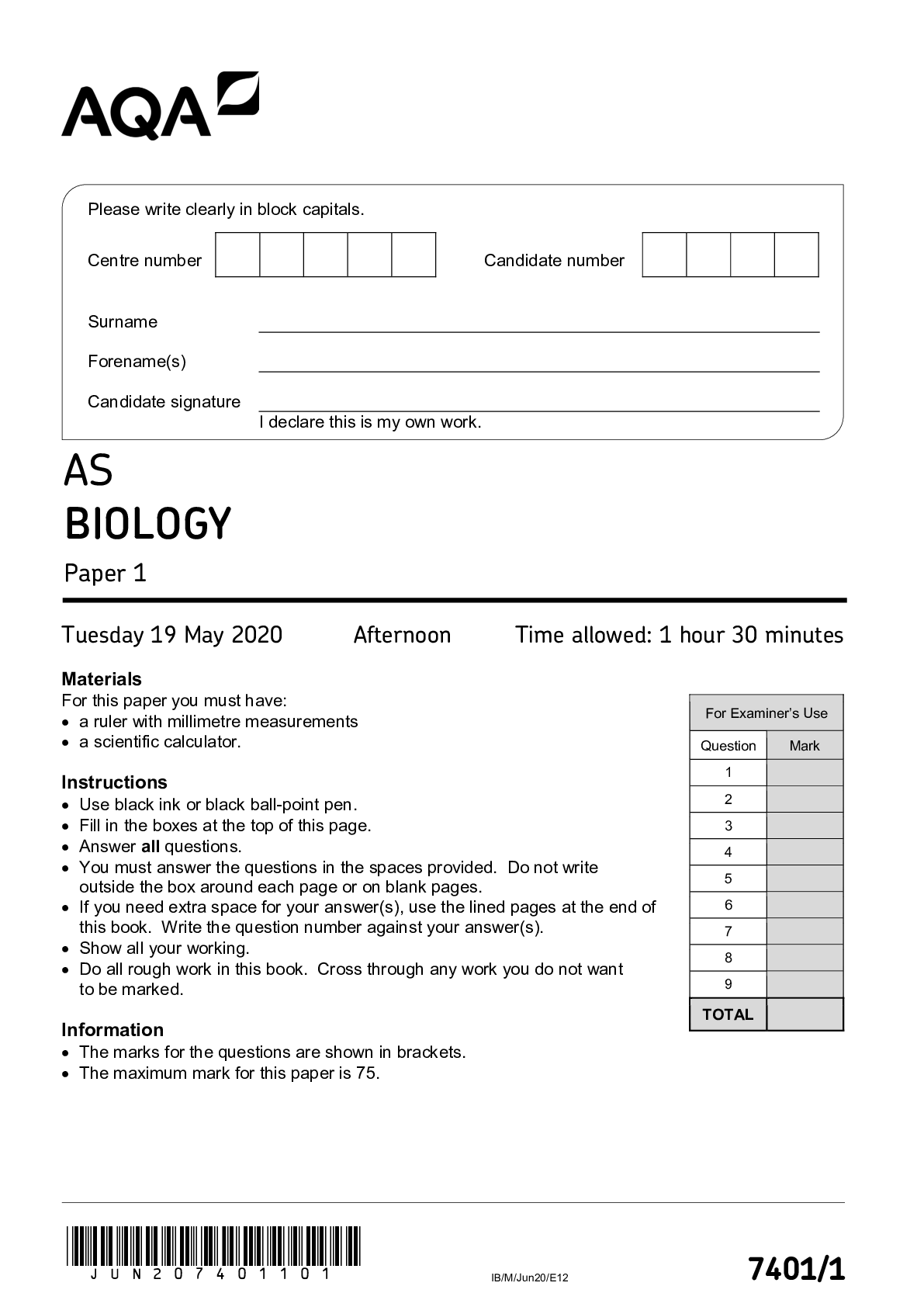
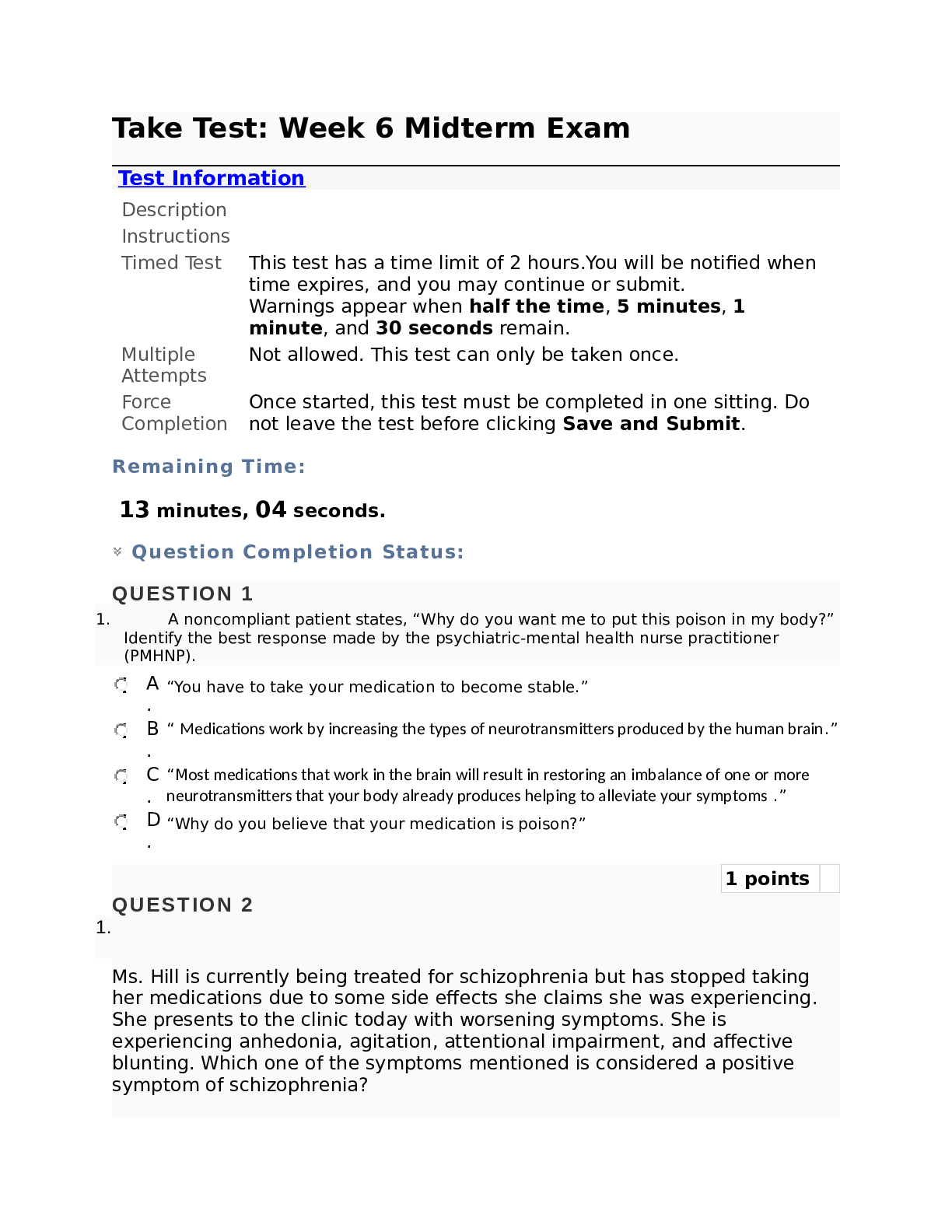





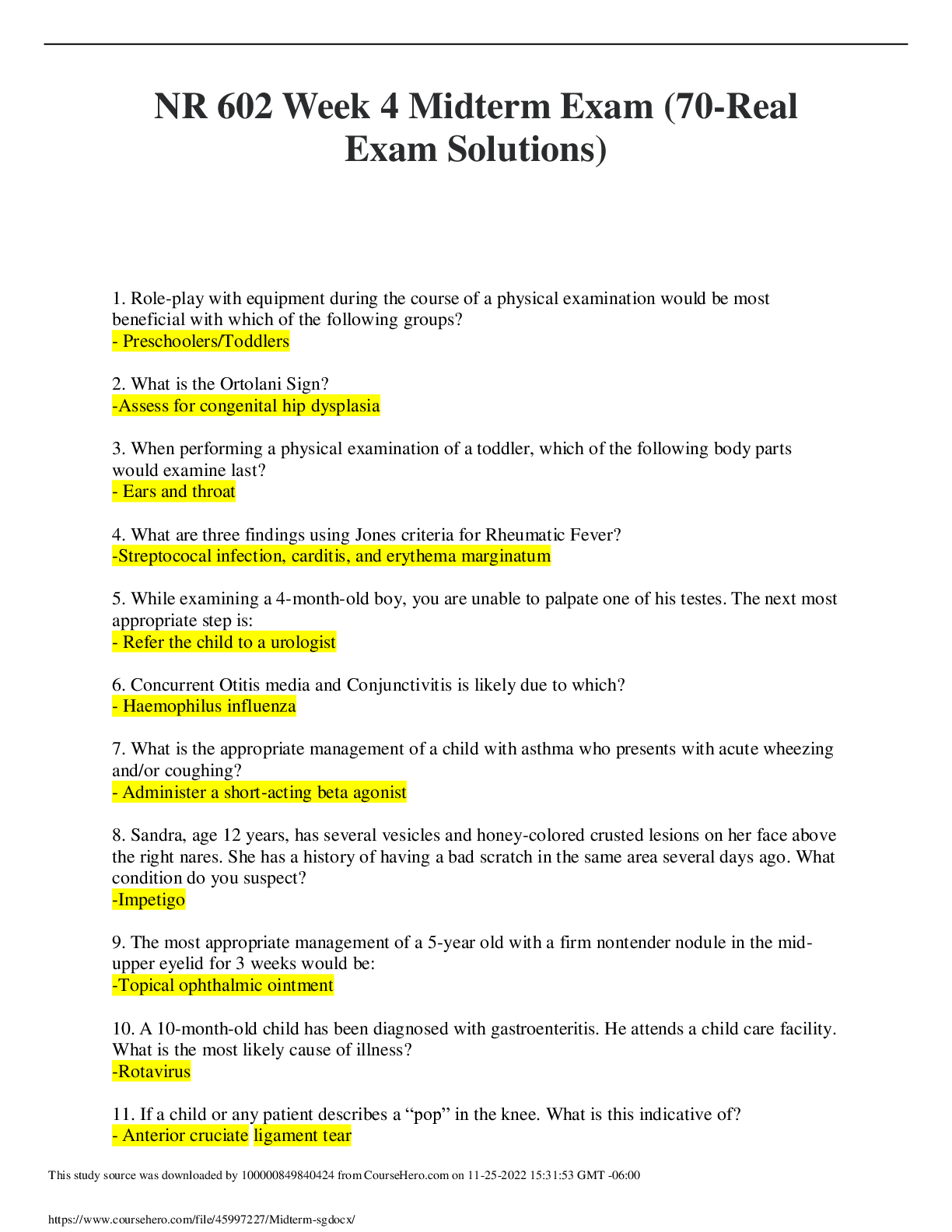
.png)
